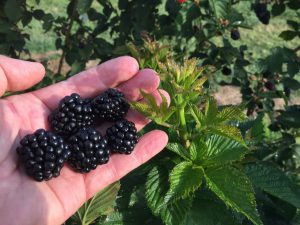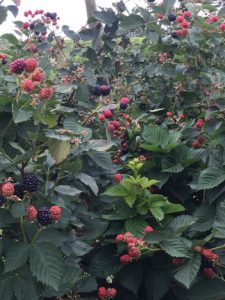Compiled by John R. Clark, University of Arkansas
In the last 20 years or so, I have focused substantially on sweeter berries, and also changes in plant form or architecture in blackberries. ‘Ponca’ is the most recent result of these areas of focus. It will have limited plant supply in the spring of 2020, but should be widely available in late 2020 and spring of 2021. This one, along with ‘Osage’ and ‘Caddo’ step up flavor components, all toward the goal to make blackberries better, and of course more popular. A few comments follow on the new ‘Ponca’.
‘Ponca’ yield potential is high and plants demonstrate excellent health. The canes have unique architecture with reduced leaf internode length that provides potential advantages in cane tipping management. Ponca has demonstrated good secondary bud crop potential following cold injury. This cultivar ripens early, similar to Natchez, providing diversification in early season cultivar choice. Ponca is a commercial cultivar with good potential for shipping, and is an exceptional choice for local-market production and home gardens. Ponca is expected to perform well in areas where Caddo, Osage, Apache, Arapaho, Ouachita, Natchez, or Navaho are adapted, including all areas of the upper South, Southeast U.S, into the Midwest, the West and Pacific Northwest.
Type: Floricane-fruiting, thornless, erect canes. Canes have shortened internodes providing for primocane tipping management advantages.
Ripening: First harvest with Natchez, two to four days before Caddo and Osage and seven days before Ouachita. Ponca can produce a secondary bud crop that begins ripening about 14-20 days after the first harvest of primary crop berries.
Berry: 6.8 g on average. Overall averages slightly larger than Osage and near that of Ouachita. Firmness rated higher than Caddo and Osage, and firmness maintained in rainy conditions.
Yield: Comparable yield potential to Caddo, Osage and Ouachita, averaging just over 20,000 lb/acre in research plantings.
Flavor: Flavor is an outstanding attribute, and Ponca is the sweetest cultivar from the Arkansas program. Soluble solids has exceeded 13% in some harvests and consistently exceeds 10%. Sweet flavor has been retained in rainy conditions also and has been consistent from harvest to harvest. Berries have reduced acidity, consistently below 1% titratable acidity. Ponca has very attractive aromatic components which round out its sweet flavor.
Postharvest: Storage has been comparable to Caddo, Ouachita and Osage for overall storage potential. Red drupelet reversion is low and similar to Osage and less than Natchez. Leakage in storage was noted to be higher than other cultivars in some years, particularly when held more than seven days. Excellent sweet flavor is retained in storage.
Plants: Ponca plants have exhibited very good health with consistently healthy floricane leaves contributing to its sweet flavor. It has shown to be disease free, having exhibited no orange rust nor anthracnose and very limited cane/leaf rust in all research trials. Winter hardiness has been comparable to Ouachita, and has shown very limited winter injury to a low of 1F. Chilling requirement is unknown, but is anticipated to be approximately 300 hours.

